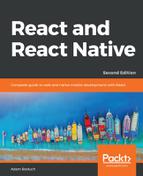To start things off, let's implement a simple layout with three sections that flex in the direction of the column (top to bottom). Let's start by taking a look at the resulting screen:

The idea with this example is that you've styled and labeled the three screen sections so that they stand out. In other words, these components wouldn't necessarily have any styling in a real application since they're used to arrange other components on the screen.
Let's take a look at the components used to create this screen layout:
import React from 'react';
import { Text, View } from 'react-native';
import styles from './styles';
// Renders three "column" sections. The "container"
// view is styled so that it's children flow from
// the top of the screen, to the bottom of the screen.
export default () => (
<View style={styles.container}>
<View style={styles.box}>
<Text style={styles.boxText}>#1</Text>
</View>
<View style={styles.box}>
<Text style={styles.boxText}>#2</Text>
</View>
<View style={styles.box}>
<Text style={styles.boxText}>#3</Text>
</View>
</View>
);
The container view (the outermost <View> component) is the column and the child views are the rows. The <Text> component is used to label each row. In terms of HTML elements, <View> is similar to a <div> while <Text> is similar to a <p>.
Now let's take a look at the styles used to create this layout:
import { Platform, StyleSheet, StatusBar } from 'react-native';
// Exports a "stylesheet" that can be used
// by React Native components. The structure is
// familiar for CSS authors.
export default StyleSheet.create({
// The "container" for the whole screen.
container: {
// Enables the flexbox layout model...
flex: 1,
// Tells the flexbox to render children from
// top to bottom...
flexDirection: 'column',
// Aligns children to the center on the container...
alignItems: 'center',
// Defines the spacing relative to other children...
justifyContent: 'space-around',
backgroundColor: 'ghostwhite',
...Platform.select({
ios: { paddingTop: 20 },
android: { paddingTop: StatusBar.currentHeight }
})
},
box: {
width: 300,
height: 100,
justifyContent: 'center',
alignItems: 'center',
backgroundColor: 'lightgray',
borderWidth: 1,
borderStyle: 'dashed',
borderColor: 'darkslategray'
},
boxText: {
color: 'darkslategray',
fontWeight: 'bold'
}
});
The flex and flexDirection properties of container enable the layout of the rows to flow from top to bottom. The alignItems and justifyContent properties align the child elements to the center of the container and add space around them, respectively.
Let's see how this layout looks when you rotate the device from a portrait orientation to a landscape orientation:

The flexbox automatically figured out how to preserve the layout for you. However, you can improve on this a little bit. For example, the landscape orientation has a lot of wasted space to the left and right now. You could create your own abstraction for the boxes that you're rendering.
